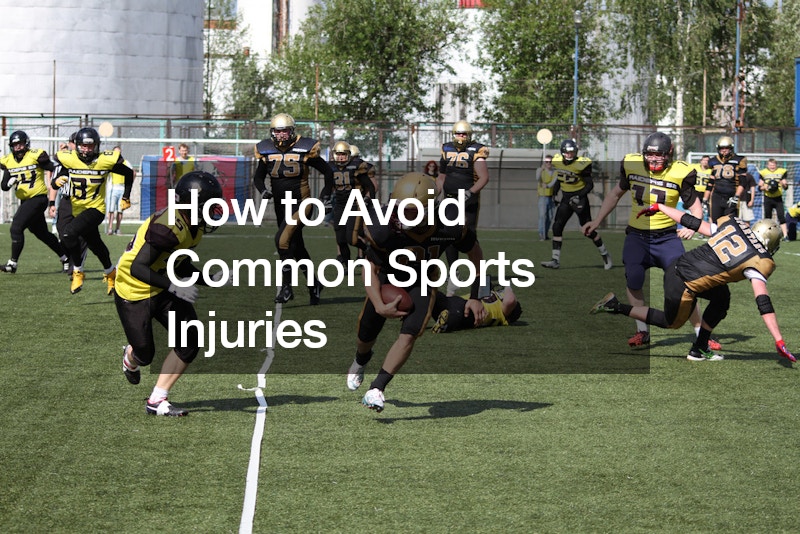
Staying injury-free is essential for enjoying sports and maintaining peak performance. In this comprehensive guide, we’ll explore effective strategies to prevent common sports injuries and keep you in the game.
Understanding Common Sports Injuries
Sports injuries can broadly be categorized into two types: acute injuries and overuse injuries. Acute injuries occur suddenly, often as a result of a twist, fall, or collision, while overuse injuries develop gradually due to repetitive stress on the body. Both types of injuries can sideline athletes and hinder their performance if not addressed promptly.
.
Preventing Acute Injuries
Acute injuries, such as sprains and strains, can be challenging to prevent entirely due to their sudden nature. However, there are steps athletes can take to minimize their risk:
Proper Warm-Up: A thorough warm-up is essential before engaging in any physical activity. This can include dynamic stretches, light jogging, and sport-specific drills to prepare the body for the demands of the sport. Maintaining
Good Form: Ensuring proper form and posture during sports activities can help reduce the risk of acute injuries. Athletes should focus on proper technique and body mechanics to avoid awkward movements that could lead to injury.
Wearing Protective Gear: Depending on the sport, wearing appropriate protective gear such as helmets, pads, and braces can help prevent or mitigate the severity of acute injuries. Investing in high-quality gear that fits properly is crucial for optimal protection.
Preventing Overuse Injuries
Overuse injuries, which result from repetitive stress on the body over time, are often more preventable than acute injuries. Here are key strategies to prevent overuse injuries:
Prehabilitation
Preparing the body for the demands of the sport through prehabilitation exercises is essential for injury prevention. This involves strength training, flexibility exercises, and conditioning programs tailored to the specific needs of the sport. Working with a sports medicine professional can help athletes develop an effective prehabilitation plan.
Proper Warm-Up and Cool-Down
A comprehensive warm-up and cool-down routine are crucial for preventing overuse injuries. Before activity, athletes should engage in dynamic stretches and light cardiovascular exercise to prepare the muscles and joints. Afterward, a cool-down consisting of static stretching can help prevent muscle tightness and stiffness.
Listening to Your Body
Paying attention to signs of fatigue, pain, or discomfort is essential for preventing overuse injuries. Ignoring these warning signs and pushing through pain can lead to further damage and prolonged recovery times. Athletes should learn to distinguish between normal muscle soreness and signs of an impending injury.
Seeking Professional Guidance
While prevention is key, injuries can still occur despite best efforts. In such cases, seeking prompt medical attention from a sports medicine professional is crucial for timely diagnosis and treatment. Sports medicine physicians are trained to evaluate and treat a wide range of sports-related injuries, from acute sprains and fractures to chronic overuse conditions.
When to See a Physician
Persistent pain or discomfort that lasts more than a week, particularly over a joint, may indicate an underlying injury that requires medical attention. Persistent pain or discomfort lingering for more than a week, especially around a joint, should ring alarm bells—it might be a sign of an underlying injury needing professional attention.
Such prolonged discomfort could indicate anything from overuse injuries like tendinitis to more serious issues like ligament tears. Brushing off persistent pain can prolong recovery time and make matters worse. Moreover, if pain ramps up during physical activity, it’s a clear signal that something isn’t right. It suggests your body’s struggling to keep up with the demands, potentially worsening an existing injury or causing a new one.
Pushing through escalating pain levels can lead to further damage. In such cases, it’s crucial to see a sports medicine physician, especially an orthopedic specialist. They’re experts in dealing with sports-related injuries and can conduct thorough evaluations, including physical exams and imaging tests like X-rays or MRIs, to pinpoint the problem accurately.
Watch out for other signs too:
Swelling and Wobbly Joints: If a joint swells up or feels unstable, it could be a sign of ligament or tendon damage that needs checking.
Can’t Move Properly: Trouble moving a joint normally due to pain or stiffness might indicate joint trouble that an orthopedic specialist should look at.
Strange Tingling or Numbness: If your extremities feel tingly, numb, or like they’re “asleep” for no reason, it could be a nerve issue that needs attention.
Looks Different: Any noticeable changes in a joint’s appearance, like swelling, bruising, or weird bumps, should get checked out ASAP to rule out breaks or dislocations.
Feels Weak or Tired: Constant weakness or fatigue in a muscle or joint, especially if it’s affecting your game, could signal an underlying problem that needs addressing. Recognizing these signs and getting timely help from an orthopedic specialist can make a big difference in recovery. So, if you’re experiencing any of these issues, don’t hesitate to seek help. Prioritizing early intervention and proper care is key to getting back on your feet and back in the game.
In conclusion, preventing common sports injuries requires a multifaceted approach that includes proper conditioning, warm-up and cool-down routines, and attentive monitoring of the body’s signals. By incorporating these strategies into their training regimen, athletes can minimize their risk of injury and enjoy a long and successful athletic career. Remember, when injuries do occur, seeking timely medical attention from a sports medicine professional is essential for a speedy recovery and return to play. Stay proactive in your injury prevention efforts, and keep striving for peak performance on and off the field.
.




